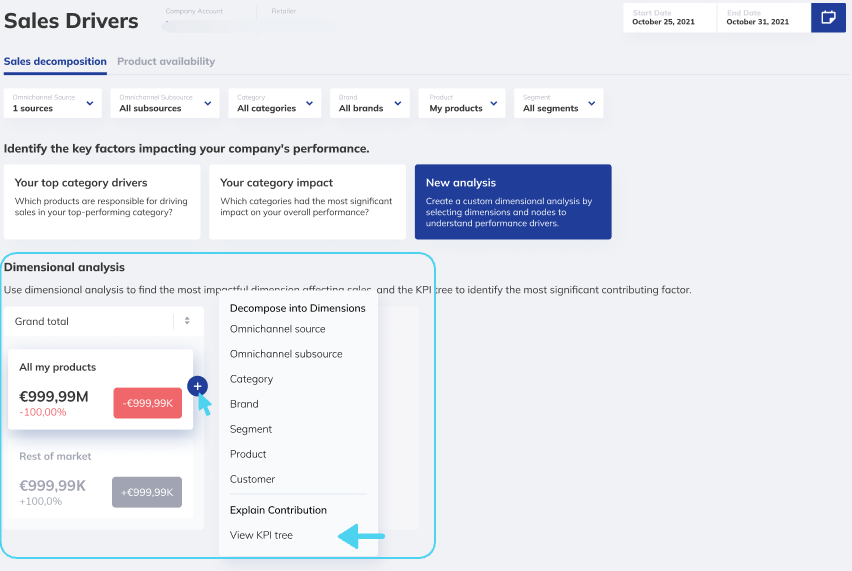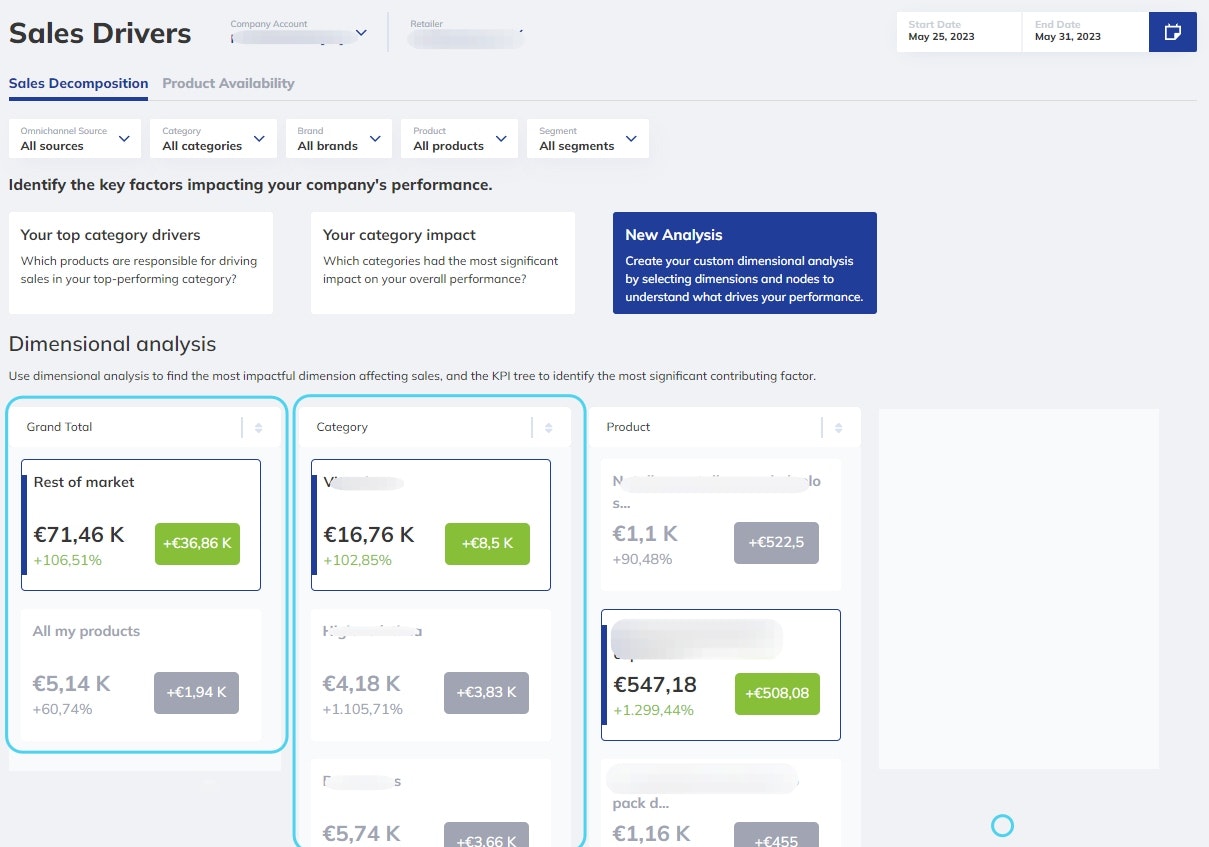




Getting Started
Sales Value Decomposition: Your Guide to In-Depth Sales Analysis 📊
Unlock the power of Sales Value Decomposition, a feature designed to make understanding your sales data easier and more intuitive.
Whether you're a seasoned pro or new to data analysis, this guide will walk you through how it works, helping you make informed decisions about your business's sales performance.
Two Ways to Explore Your Data 🛤️
Sales Value Decomposition offers two modes of analysis:
Dimensional Decomposition: Imagine this as a microscope for your sales data, allowing you to zoom in on specific aspects by breaking down the sales value of a group into smaller, manageable sub-groups.
KPI Tree Decomposition: Picture this as a family tree of your Key Performance Indicators (KPIs), revealing what's driving your overall sales performance and empowering you to make informed decisions.

Understanding the key parts of Sales Decomposition
Meet the Key Components 🧩
To make your analysis seamless, it's essential to grasp a few key components:
1. Nodes 🧱
These are the building blocks of your analysis, representing sub-groups like brands or specific product metrics such as the number of products sold. The first node in your analysis is the root node, while the last is the terminal node.
Nodes provide crucial information:
The name of the group or metric.
The value of the focused metric, the sales value for a group in other words.
The percentage change of sales value compared to the previous period.
The contribution to total growth, reported in the retailer's currency.
2. Columns 📚
Columns are handy when you're doing dimensional decomposition. They list all the nodes within a specific dimension. Do you need to decompose your competitors' performance in each category? Then you analyse "Rest of market" node (column 1) per brand (column 2)🗂️
3. Trees 🌳
Trees are what you'll work with in KPI Tree Decomposition. They illustrate the connections between various sub-metrics. 🌲

Dimensional Decomposition: Dive into the Details
Dimensional Decomposition allows you to drill down into your sales data with a structured approach:
Start from a root node that includes all your products or data from different brands.
For instance: Start with "All your products" or "All your brands." 🌐
Delve deeper to find out which categories within the top-performing brand contributed the most to their growth.
For example: From "All your products," move to "Brands," and then to "Categories." 🚀
Finally, zoom in to see which specific products within the top brand and category performed exceptionally well or struggled.
Like this: "All your products" > "Brands" > "Categories" > "Products." 🔎

KPI Tree: Uncover the Driving Factors
The KPI Tree gives you a hierarchical view of your Key Performance Indicators (KPIs).
It's like peeling back the layers of an onion to find out what's at the core of your sales performance. 🧅
Demand / Price / Assortment Decomposition Tree 📦
This analysis helps you understand how changes in metrics like demand, price, and assortment influence your sales the most.
Demand
Demand measures the impact on sales value resulting from the change in the quantity sold of comparable products.
🧮 How are these metrics calculated?
Demand
Total units sold during the period we analyze for products with sales in both current & compare periods.
Do people buy more or fewer units now? What's the contribution of units sold for those products that has sales now and before?Orders
The total number of orders (baskets) taking place during the period you analyze, including at least one product with sales in both current & compare periods.Do they make more purchases now or before? What's the contribution of the change in the number of orders?Customers
The number of customers who shopped at least one product with sales during both periods (current & compare).Is the number of customers affecting the performance? What's the contribution of the change in the number of customers buying now and before?Orders per Customer
The total number of orders per customer who shopped at least one product with sales during both periods (current & compare).Does each customer make more or fewer purchases now compared to the previous period? What's the contribution of their frequency of buys?
Units per Order
The number of units sold per order, for orders including at least one product sold in both the current and compare period.Do they buy more or fewer units now in each order? What's the effect of any changes?
Price
Price refers to the contribution of pricing changes during your analysis period.
🧮 How are these metrics calculated?
Price: The total sales value divided by the number of units sold during the current period for all products with sales in both current and compare periods.
Are there any differences in the average unit price now versus before? What's their contribution?Selling Price: Estimating the contribution of price increases or decreases during the current period.
What's the contribution in performance of any increases/decreases in each product's selling price?Product Mix: An estimation of the extent to which consumers switch their spending from lower-priced to higher-priced products, and vice versa, within the range of products sold in both periods.
Are people purchasing larger quantities of products with higher or lower prices compared to before? What is the impact of shifting demand between premium and affordable products?
Assortment
Assortment refers to the contribution of sales value resulting from changes in your assortment (like newly launched or delisted products).
🧮 How are these metrics calculated?
Assortment
The number of unique products that had sales during the current period.
What portion of the sales value can be attributed to potential assortment updates?Expansion
Refers to the number of products that had sales during the period you analyze but not during the previous one. These products are typically new launches, but may also include products that were unavailable in the retailer before.What's the contribution of newly launched or available again products in performance?Reduction
Refers to the number of products that had sales during the previous period but not during the current period. These products are typically delisted from the retailer, but may also include products that are unavailable or with no sales now.What's the contribution of delisted or not available now products in performance?
